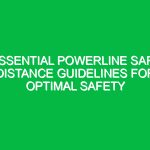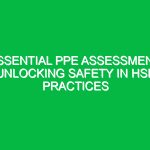Introduction
Good morning, everyone! Today, we’re going to have an essential toolbox talk focused on a critical aspect of our workplace: Taking Action to Work Safe. Safety is not just a set of rules; it’s an ongoing commitment that we must all engage in daily. As we prepare to start our workday, let’s take some time to discuss the importance of this topic and how each of us plays a vital role in maintaining a safe work Environment.
Understanding the Importance of Safety
Before we dive into specific strategies, let’s take a moment to reflect on why Safety matters. Every year, countless workplace accidents occur, often leading to injuries, lost time, and even fatalities. These incidents not only affect the individuals involved but also impact families, coworkers, and the organization as a whole. By Taking Action to Work Safe, we can significantly reduce these risks and create a culture where safety is prioritized.
Key Components of Taking Action to Work Safe
When we talk about Taking Action to Work Safe, several key components come to mind:
- Awareness: Understanding the Hazards present in our work environment.
- Preparation: Having the right tools, equipment, and knowledge to handle tasks safely.
- Communication: Sharing safety concerns and Best Practices among team members.
- Responsibility: Taking ownership of our actions and their impact on Workplace Safety.
Awareness: Recognizing Hazards
The first step in Taking Action to Work Safe is being aware of the potential hazards in our workplace. This includes both physical hazards, like machinery and tools, and environmental hazards, such as slips, trips, and falls. Let’s consider a scenario: imagine you’re working on a construction site. There are heavy equipment and materials around you. It’s crucial to be aware of your surroundings and identify any potential risks. Regularly conducting safety audits and inspections can help us stay vigilant and informed.
Preparation: Equipping Yourself for Safety
Preparation is key to ensuring safety. This means not only having the right Personal Protective Equipment (PPE) but also being trained in how to use it effectively. For instance, if you’re working with hazardous materials, wearing gloves, goggles, and respiratory protection is essential. But it’s not just about having the gear; you need to know when to use it and how to maintain it. Regular Training sessions and refreshers are vital in keeping safety protocols fresh in our minds.
Communication: Sharing Information
Effective communication is fundamental in promoting safety. This includes reporting any unsafe conditions or practices and encouraging open dialogue about safety concerns. For example, if you notice a colleague not wearing their safety helmet while Working at Height, speak up! Addressing these issues promptly can prevent accidents. Additionally, regular toolbox talks are a great way to keep everyone informed and engaged in safety discussions.
Responsibility: Taking Ownership
Finally, each one of us must take responsibility for our safety and that of our colleagues. This means following safety protocols and being proactive about identifying and mitigating risks. If you’re in a supervisory role, it’s your responsibility to lead by example. If you’re a team member, your feedback and vigilance can make a significant difference. Remember, safety is a collective effort, and we all play a part.
Real-Life Examples and Scenarios
Let’s look at some real-life examples that illustrate the importance of Taking Action to Work Safe.
Example 1: The Importance of Proper Lifting Techniques
Consider a warehouse worker who regularly lifts heavy boxes. One day, they decide to lift a particularly heavy box without asking for help. As a result, they strain their back and end up needing medical attention. This incident could have been avoided if the worker had taken a moment to assess the situation and ask for assistance or used proper lifting techniques. Always remember: it’s better to ask for help than to risk injury.
Example 2: The Role of Communication
Another example involves a construction site where a worker notices a loose cable on the ground. Instead of mentioning it, they walk past it. Later, someone trips over the cable and injures themselves. This incident highlights the importance of communication. If the worker had reported the hazard, it could have been addressed immediately, preventing the accident.
Best Practices for Taking Action to Work Safe
Now that we’ve discussed the components and examples, let’s go over some Best Practices that you can implement in your daily routine.
- Conduct Daily Safety Checks: Every morning, take a few minutes to inspect your work area for hazards.
- Participate in Training: Engage in all safety training sessions and encourage your teammates to do the same.
- Use the Right Tools: Always utilize the appropriate tools and equipment for the job at hand.
- Document Safety Issues: Keep a record of any safety concerns and report them to your supervisor.
- Encourage Team Participation: Foster a culture where everyone feels comfortable discussing safety and sharing ideas.
Potential Hazards and Risks
Understanding potential hazards is crucial in Taking Action to Work Safe. Here are some common risks you may encounter in the workplace:
Physical Hazards
Physical hazards include anything that can cause harm through direct contact, such as machinery, vehicles, and electrical equipment. Always ensure that safety guards are in place and functioning and that you are trained in the Operation of any machinery you use.
Chemical Hazards
Chemical hazards can arise from the use of solvents, paints, and other substances. It’s vital to read Safety Data Sheets (SDS) and understand the proper handling Procedures for these materials. Always wear the recommended PPE when working with chemicals.
Ergonomic Hazards
Ergonomic hazards occur when the job demands do not match the physical capabilities of the worker. This can lead to musculoskeletal injuries. Make sure to adjust your workstation to fit your needs and take breaks to prevent strain.
Regulations and Standards
In our commitment to Taking Action to Work Safe, we must be aware of the Regulations and standards that govern Workplace Safety. These include:
- Occupational Safety and Health Administration (OSHA): osha sets guidelines and regulations designed to ensure worker safety across various industries.
- Environmental Protection Agency (EPA): The EPA oversees regulations related to Chemical Safety and environmental protection.
- Company Policies: Familiarize yourself with your company’s safety policies and procedures, as they often reflect industry standards.
Compliance with these regulations is not just about avoiding fines; it’s about ensuring a safe working environment for everyone. Understanding these guidelines helps us fulfill our legal obligations and creates a culture of safety within our workplace.
Conclusion
As we wrap up today’s toolbox talk, I want to emphasize that Taking Action to Work Safe is a shared responsibility. By being aware of our surroundings, preparing adequately, communicating effectively, and taking ownership of our safety, we can create a culture that prioritizes well-being.
Thank you for your attention and your commitment to safety. Let’s continue to look out for one another and make our workplace a safe environment for everyone. Remember, safety is not just a priority; it’s a way of life here.


